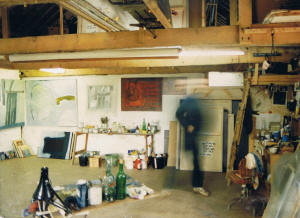 |
|||
| home | features | exhibitions | interviews | profiles | gazetteer | links | archive | forum | |||
|
Jeremy Annear on Painting, European modernism, and the Cornish art scene in the 80s
Jeremy, I understand you went to art school in Devon at the end of the sixties and were there, involved in the art scene in various capacities, for a further 20 years or so. Can you expand on this? Were you also active as an artist during this time and if so what was your work like? Yes, Exeter was my hometown and I did go to Exeter College of Art when it was still in its old Gandy Street location. I had some great teachers. Those that come immediately to mind are: Harry Thrubron, Bernard Cohen, Clifford Fishwick, Dan Davidson and Marek Ladzinski. I was fortunate to be involved in a surrealist festival in Exeter sometime in the late 60’s which was overseen by George Melly - with a visit from Roland Penrose which in itself was a highly surreal happening! The drawings of Masson and Penrose especially attracted me. I was very impressed by this event and it certainly was a significant influence on my personal and artistic development. There was also a pseudo-spiritual preoccupation in all the arts at this time (hippy/flower power) and a kind of updating of theosophical ideas which had been influential to the early 20thC development of constructivism and modernism.
In my own
personal search for an authentic spirituality I retreated for about 6
months to a strict I had 4 children by the time I was 24. I had to make a living with so many mouths to feed. Gradually I was able to commit more consistently to my painting. I was teaching art by 1973 and managed at least to be involved in the arts community in and around Devon. I became involved for a number of years with Devon County Education Authority running courses for the Visually Gifted at Dartington College of Arts. I worked closely with Bob Clements the senior Art Advisor for DCC. He was nationally known for his work as an innovative and exciting Art Educator and I was very fortunate to work with him and benefit from his philosophy and experience. I taught life drawing and printmaking for many years in adult education and on the foundation course at South Devon College of Art. During this time I met the charismatic Painter printmaker and Musicologist Tony Evora who had been exiled from Cuba. He and his family became great friends and we worked on several teaching projects together.
I was
involved at the time with setting up Ryder’s Gallery at Dartington where
we were mounted exhibitions arts events and forums for the campus and
community of Dartington. I had become interested at the time in
performance art and jointly organised a celebrated festival of performance
art at Dartington in the early 80’s. It was politically edgy and
conceptually radical. It was very often highly controversial and
provocative. I remember, for example, a fantastic 24hr piece by Alastair
MacLennan whose work I have always greatly admired. I also got to know the
internationally
What were your influences then and have they changed much? You’ve previously described yourself to me as ‘European-modernist’. What does this phrase mean to you? I fell for modernism in my early teen years whilst looking at architecture and in St Ives during school holidays where I encountered real modern art at first hand. At the time I was just overwhelmed by it, its freedom and purity of form and construction. The wonderful natural and earth colours set against primary. The use of scraphito line and the building and layering of paint, all these things sent goose pimples down my back and I knew then that something had deeply influenced me but certainly couldn’t articulate it at the age of 12 or 13. Later at school my art teacher helped me to understand where modernism had come from in an art historical sense and I begun to understand it. By the time I got to art school I had a strongly modernist influence. That’s not to say that I or anyone else called ourselves anything other than art students. Labels and definitions were not commonly used except in an art historical context. Art History
taught us that we had all come from the same place. A pure lineage from
Quattro cento Italian art to El Greco through to Rembrandt to 19th
century French art and impressionism. Post Modernism changed all that.
Memorable exhibitions influences and events were Picasso, American
abstract expressionism, The Rothko room at the old Tate Gallery, Kettle’s
Yard, Cambridge, Brancusi, William Hayter, Miro, Klee. During this period
I was lucky to gather a handful of Swiss and German admirers of my work
which allowed several visits there and broadened and deepened my
experience These were the days just before e.g. John Berger’s ‘Ways of seeing’ came with a re-evaluation and dismantling of linear art history and a reaffirmation of Marxist theories. This to me was the birth of post- modernism which has been an extraordinarily successful cultural revolution. I sometimes regret this success and the loss of modernism. Times have changed so rapidly in the last two decades and the art bubble has truly exploded. The new vital and emerging scene is largely unaware of Cornwall’s very recent art history and its direct and diverse links to Constructivism, Bauhaus, Cubism, Dada, Surrealism, Abstract Expressionism, Kinetic, Op, Performance, Installation, Photorealism, Experimental, Photography and Film etc. and it all existed together.
You moved to Cornwall, I think, in the late 80s having already showed with the Penwith and Newlyn Societies before then. Can you cast your mind back to then and paint a picture of what the art-scene in Cornwall was like - at least as you remember it? I actually moved to Cornwall with the painter Judy Buxton (now my wife) in 1987 where we first lived on a boat in Falmouth Marina. I had given up teaching to commit fully to work. In order to make money I did odd building and decoration jobs. Soon after moving here I met Leonard and Gill Williams. Leonard was a great supporter of the Arts in Cornwall and had amongst many other public responsibilities been the chairman of the trustees of the Penwith Society of painters. He was very kind and generous to us. He gave me work recobbling the yard at Arwennack where we tried to recreate the original. It was a time consuming and painstaking job. He always treated me as a Painter and with the greatest respect and constantly encouraged me as an artist and was an admirer of my work. He and Gill remained great friends.
Yes. It dates back to the 14th Century. Percy Williams and Son used to be a large firm of Builders which Leonard directed until his death. I can remember Leonard giving me quantities of old powdered pigments that the firm had once made their decorating paints from. He also took me and Judy to see several redundant properties that he owned with a possibility of them becoming Studios for us. This never materialised but was fun while it lasted. Arwennak has a substantial sculpture by Paul Mount in the front garden of the house and can be seen from the road. This was commissioned by Leonard and Jill Williams. I am grateful to many friends for employing me as an ‘artist’ to decorate their homes in those early days in Cornwall. It was typical of the art scene in Cornwall at the time. By today’s standards it was small but didn’t feel so at the time. We all knew each other and it was very supportive and friendly. Although I had shown at Newlyn Orion several times before moving here we very quickly became part of the Scene. I soon moved to a new studio just outside Marazion where I was able to sleep and work uninterrupted day in day out. (Judy at this time stayed in Falmouth where she was doing Fine Art Painting and only came to stay at the weekends). I seldom went out except to buy food and walk the landscape (which has always been a part of my daily practice). It was a very good time for me and my language began to blossom and grow. I was showing most of the time in the Salt house Gallery, New Craftsman and the Newlyn and Penwith group shows.
At
this time between 1987 and 1990 I got to know Ralph Freeman, Russell
Hedges, Peter Cox (later to become Fox) who was my picture framer, Steve
Dove, Roy Walker, and Mike Chalwyn, and very soon
Again soon after this I met Terry Frost and Dennis Mitchell, Karl Weschke, John Clark, Margo Maeckelberghe, Bob Crossley, Roy Ray, Alex Mckenzie and Tony and Jane O’Malley. I met Michael Finn and he and Ceely his wife became close friends of ours. We have a wonderful painting of his that they gave us for a wedding present. Out of all the painters I knew at this time I think I have the greatest admiration for Michael. He became my mentor although his great humility would have been embarrassed by my saying so. I had been exhibiting with the Newlyn Society of Artists for sometime before I moved to Cornwall. Clive Blackmore and his partner Anne Aslan often accommodated me on these visits. Anne is a lifelong friend and I first met Clive in the early eighties. The Newlyn Society and Penwith society will be well known to readers, but you also showed at the Salthouse Gallery - which, arguably at the time, was one of the most influential galleries in Cornwall. The Newlyn Orion (now Newlyn Art Gallery) run by John Halkes and The Penwith managed by Cathy Watkins were central to everything in Cornwall then. Cathy is still there to this day and still frightens me! (She should be recognised in some way , she certainly deserves a medal!). These were both public galleries (in the old sense) and both were run for their artists: The Newlyn and Penwith Society of Artists. They were distinct from each other and although both shared many of the same artists their character was entirely different. I was a member of both which meant that I had two year round public exhibition spaces within which to show my work. They both had Summer Easter and Christmas Shows each show lasting approximately one month. At each show I could have between one and three paintings selected. That meant that in one year I had the potential of showing 36 new works for six months of the year. (I never did actually show this number but I worked towards it). The shows were selected by artist committees and it was competitive. It was necessary therefore to be highly selective oneself and only submit the very best or most significant work from the studio. Because these Galleries were run by and for their artists they were always important socially and communally as meeting places and places were one could catch up with the latest buzz, exchange ideas meet new friends and arrange studio visits etc. During this time most of the big name second generation artists were in their prime and although most of them by then were showing mostly out of Cornwall and mostly in London from time to time they would put work into shows. This always added to the excitement of a new opening. It was also great when they turned up at private views and we had the opportunity to meet them. At the Penwith there was a good space that artist could rent either for themselves or a small group of for an invited artist. I saw several interesting shows here. The Newlyn Orion, where John Halkes took a more curatorial lead, there were many very good retrospective and other exhibitions. These were often important National shows which would bring important and influential people down to Cornwall. The nineties and the end of the millennia were bubbling around the corner. There was a great spirit around and it proceeded a very important time for me with extended periods spent working in Australia and Germany during the following five years. So its true that The Penwith and Newlyn Societies were at the hub of things. But at that time ‘Boots’ Redgrave at The New Craftsman, and ‘Gillie’ at The Wills Lane were both also running significant and important galleries. At the
Salthouse, the important and tireless contribution of Bob Devereux should not be
underestimated. He took risks all the time giving many new and upcoming
artists shows based purely on their work without any consideration of
potential sales. Bob gave me my first solo show in Cornwall and showed
Simon Averill in another space at the same time. He subsequently became a
good We were all struggling but it was good. The private views were fantastic then and I wouldn’t miss one. Usually quantities of Bulgarian red were consumed and we talked excitedly about the art and art!! I am indebted to several people from those days that backed me and collected my work. Sandra Lummis of Sandra Lummis Fine Art, London-now defunct-collected and sold my work. She was well known as an authority on the Bloomsbury Group and a dealer/collector of their work. It always amazed me that she took such an interest in me. Boots Redgrave of the New Craftsman invested in my paintings and at one stage gave me a small stipend to live on. That was indescribably encouraging. Over the years others have followed suit and expressed their appreciation of my work by buying it! This has never ceased to amaze me and I am deeply grateful that I can now paint and live from my work after nearly 40 years. I never expected a short apprenticeship!
Thinking about the galleries, I also remember the Wolf at the Door Gallery in Penzance - now closed - being one of the better ones. And the Rainyday. More significantly there was also of course a situation when there was nothing much outside of Penwith. The idea that there might be 4 or 5 significant galleries in Truro of all places as there are now would have been unthinkable. Yes, every body was excited by the opening of the Wolf At The Door gallery and it certainly left its mark staging several historical shows. I never showed there. At the same time Martin Val Baker had the Rainy Day gallery in his print shop and also mounted several important shows.
For a while you had a studio at Porthleven. What was significant about being there in particular? There are a number of artist’s studios there aren’t there? I moved to a new studio in Porthleven in ‘89. This was an important time for me. I had found my stride as a painter and I needed more space. Lots of things were developing and I had started to earn a bit more from painting sales. It was also a sociable and exciting time as well with much activity from artists and dealers. Porthleven had become quite a centre for artists. The Acme studios provided 6 large studios some of which were subdivided and shared. There were other spaces around and Bryan Ingham also moved to a studio at this time. The OYOYOY dinner party almost became an institution amongst Porthleven artists in the late eighties. It usually took place with about 8 or 10 of us in are first floor flat in Penair House overlooking the mouth of the harbour (which incidentally was rented to us by Daphne McClure) or at John and Carole McDowell’s home just over the way. The evenings consisted of a really good meal, lots of Bulgarian red wine and intense art discussion usually winding up just before dawn! These discussions were passionate heated and noisy and on these occasions we appointed one of us to chair. There were many creative spin offs from these evenings. ‘Pomo’ and ‘popomo’ were often alluded to. One of the consequences of these evenings was the formation of the Cobalt Group.
The impression I have of that time – which was pre-Tate St Ives - is that a tradition of Cornish (St Ives) modernism was still very strong. If Nicholson and Hepworth - who started exhibiting in the 30s are the first generation Cornish modernists and Lanyon, Frost et al who started showing in the 50s and 60s are the second generation, then arguably, artists like yourself, Bob Devereux, Breon O'Casey and Tony O'Malley would make up a 3rd generation who were mainly exhibiting and active in the 70s and 80s – but who were still continuing the same tradition of abstract painting. Would
you broadly agree that this kind of analysis can be useful, even though it
is a bit simplistic?
I have always been somewhat ambivalent about the Tate. It has been great in many ways but it has also been a ‘dead hand’ on the lively and active scene that used to exist. I always felt it was a mistake to take St Ives modernism out of London but then when it came one realised how poorly The Tate had collected and invested in art of the 50’s and 60’s. The curatorial professionalism that came with the Tate also seemed to bring with it a new breed of impersonal administrators and managers largely disinterested in exploring the rich pickings in their own back yard. As far as I know there has never been any attempted to document or archive art in Cornwall since the mid sixties and there has been very little direct connection with artist working in Cornwall. I think it has missed a great opportunity. There is no doubt however that the Tate has generated ‘businesses and commerce’ and is very much part of the new Cornish ‘cool’. I broadly agree with your analysis although names and lists are always difficult to pin down especially as many of the so-called third generation are still alive! If I place myself at late third generation then the other important names to me would be Anthony Frost, Micheal Finn. Tony O’Malley, Jeremy LeGrice, Daphne McClure, Carole McDowell, Russ Hedges, Ralph Freeman Steve Dove, Roy Ray, John Clark, Clive Blackmore, Simon Averill, Roy Walker, Bob Devereux, John Emmanuel, Bob Crossley and Andrew Lanyon.
What do you feel these 3rd generation artists have in common? In what ways is their work different from the 1st and 2nd generation artists in your opinion? Were their sympathies more with European than with American art would you say? I think The Elemental landscape and a love of Cornwall would be the common ground. I would say on the whole that the American abstract expressionism was more influential. It was a more recent movement and there were quite a lot of direct connections between 50’s 60’s St Ives and America.
I don’t think there was much interest in the late eighties/early 90s in what you might call post-modern or post-conceptual art down here then, and art in new media, which probably reflected what was happening elsewhere in the art-world. But I do think that’s changed, probably influenced as much as anything, by the high profile given to the YBA’s by the Turner Prize and the like. The digital age hadn’t arrived. There were endless happenings and installations etc carried out by the artist already mentioned it just wasn’t documented. Its easy to forget how rapidly digital technology has developed and influenced new media. Its impact has been enormous on the social network of the artistic community and the process of making art. It has affected the way we view images and the way we look at things. Sometimes - only sometimes - I would like to bring back the dinosaurs… just to create a bit of danger!
http: www.jeremyannear.co.uk
|
|||
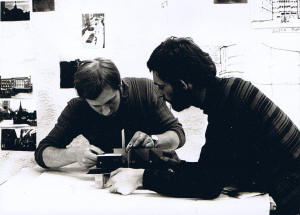
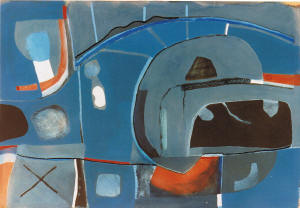
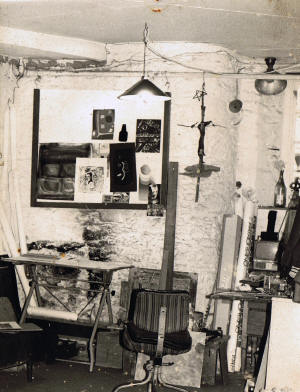
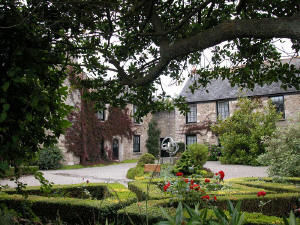
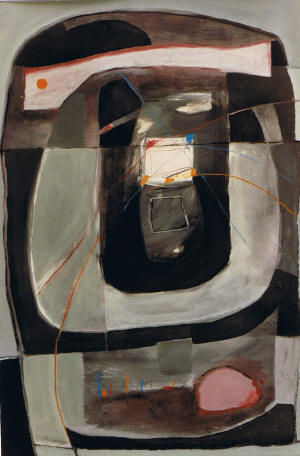
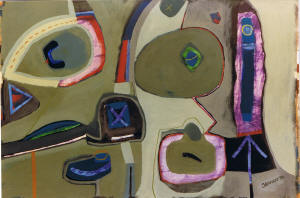
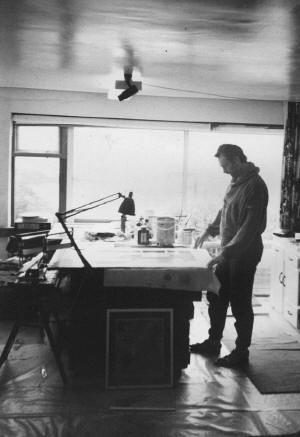
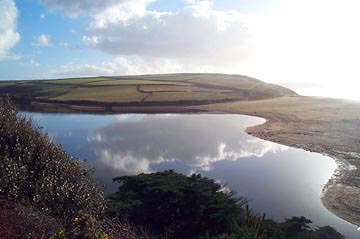 The Cobalt
group was formed about 1989 to challenge and question the given work
processes of its members in daylong workshops at the Acme Studios in
Porthleven. The members of the group were Carole McDowell, Ralph Freeman,
Roy Walker, Russ Hedges, and myself. John McDowell filmed all the
workshops. I cannot remember exactly how many times we met but probably
about 6 times over about a year. The workshops had an element of happening
to them and one explored Loe Pool through site-specific installations.
Another site-specific project that I was involved in with Ralph Freeman
was called Atlantic Drift coinciding with the Newlyn Fish Festival.
Plastic rubbish collected from Marazion beach over several months was
reassembled to form a garden at Newlyn Gallery. It made a strong point
about beach rubbish and the environment and attracted much attention from
the public.
The Cobalt
group was formed about 1989 to challenge and question the given work
processes of its members in daylong workshops at the Acme Studios in
Porthleven. The members of the group were Carole McDowell, Ralph Freeman,
Roy Walker, Russ Hedges, and myself. John McDowell filmed all the
workshops. I cannot remember exactly how many times we met but probably
about 6 times over about a year. The workshops had an element of happening
to them and one explored Loe Pool through site-specific installations.
Another site-specific project that I was involved in with Ralph Freeman
was called Atlantic Drift coinciding with the Newlyn Fish Festival.
Plastic rubbish collected from Marazion beach over several months was
reassembled to form a garden at Newlyn Gallery. It made a strong point
about beach rubbish and the environment and attracted much attention from
the public.